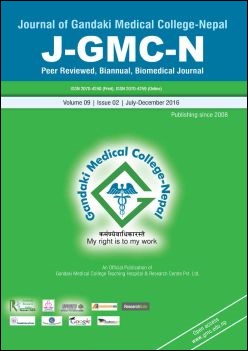Prevalence and Factors Affecting Women with Uterine Prolapse in Lekhnath, Kaski, Nepal
DOI:
https://doi.org/10.3126/jgmcn.v9i2.17870Keywords:
Prevalence, Uterine prolapse, WomenAbstract
Background: Uterine prolapse is the main public health problem of reproductive age women in Nepal. Uterine prolapse (UP), which affects about 10% of women of reproductive age in Nepal, is the most frequently reported cause of poor health in women of reproductive age and postmenopausal women. Currently, women’s awareness of UP is unknown, and attempts to unravel the UP problem are inadequate.
Objectives: The objectives of this study was to determine prevalence of uterine prolapse, to explore factors affecting women with uterine prolapse and to find association between selected variables and prevalence of uterine prolapse.
Methods: A community based cross sectional study was conducted from 7th July, 2016 to 7th of August, 2016 among married women with at least one child in the Ritthepani, Ward No 2, Lekhnath. Participants were selected by purposive sampling techniques, and data were collected through structured interview schedule. Frequency, percentage, mean, SD and chi-square test was performed to identify factors associated with prevalence of uterine prolapse.
Results: The major findings were majority 35 (35%) of women were in the age group of 20 to 30 years, followed by 89 (89%) Hindu religion, 48 (48%) belonged to janajati and religious minority which included Newar, Magar, Gurung, Tamang and Muslims. Most of the women 35 (35%) were Illiterate, 44 (44%) earn their living by working in agriculture, 57 (57%) respondents had ≥Rs1500 per month income in the family, 58 (58%) belonged to nuclear families, 76 (76%) of the respondents had knowledge about uterine prolapse and they got information mostly from 24 (24%) friends. The prevalence rate of women with uterine prolapse was found to be 13% whereas mean and standard deviation were 0.87 ±0.33. The findings of association between the prevalence of uterine prolapse with age at first child birth, abortion, sexual intercourse immediate after delivery and constipation were found to be significantly associated. Almost all respondents replied that uterine prolapse can be prevented by avoiding strenuous activities during antenatal and postnatal period followed by avoiding giving birth to too many babies, taking nutritious diet, deliver the baby in health institution by health personnel, avoiding long term coughing and chronic constipation.
Conclusion: Uterine prolapse was observed among women of Ritthepani ward no 2; among them most of them were age group between 20 - 30 year early married Illiterate. The perceived service was taken by less number of eligible women. Women awareness towards the problem, limiting frequent pregnancies and provision of educational opportunities are recommended for the prevention of uterine prolapse.
Journal of Gandaki Medical College
Volume, 09, Number 2, July December 2016, Page: 47-51
Downloads
Downloads
Published
How to Cite
Issue
Section
License
This license allows reusers to distribute, remix, adapt, and build upon the material in any medium or format for noncommercial purposes only, and only so long as attribution is given to the creator.

